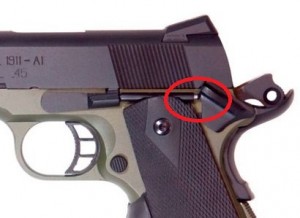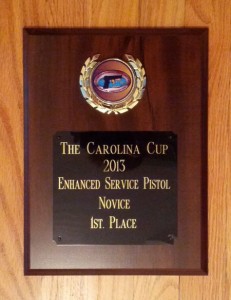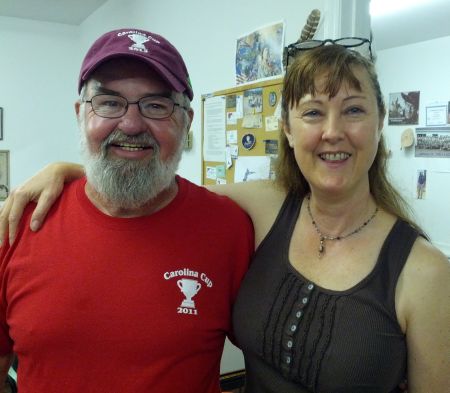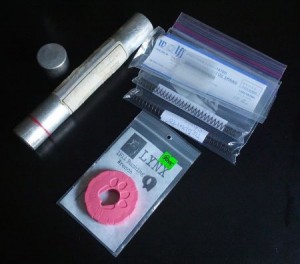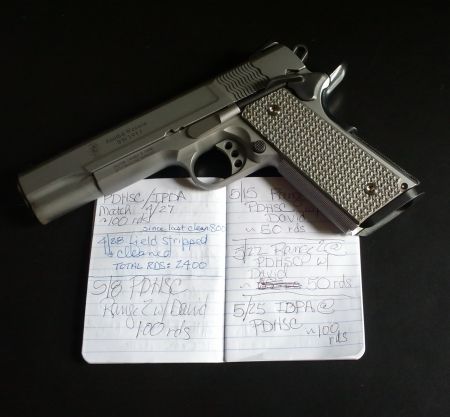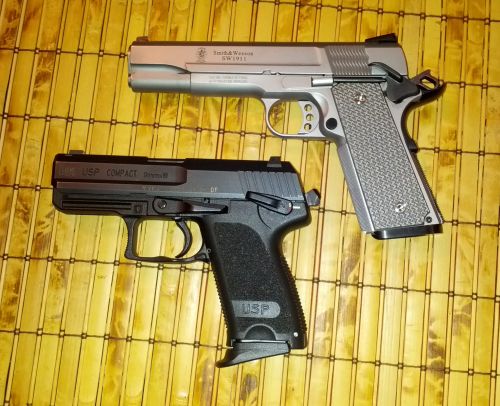After a long hiatus, I competed in a pistol competition last night. Before you wonder too much about the title of the post, an “M” or a “mike” is a miss on one of the targets. My goals were:
- be safe
- don’t get DQ’d (disqualified for unsafe behavior)
- focus on accuracy, not time
I considered this a roaring success! I finished near the bottom of the list but I had “no mikes”, did not hit a non-threat (good guy) and I was pleased with my “penalty” scores (lower is better).
The last time I competed was the 2013 Carolina Cup. That was 15 months ago. I stepped back for a list of reasons but I missed competing. As time passed, I felt inadequate about my skills and was hesitant to get restarted. Then the perfect opportunity popped up and I ditched the excuses and jumped onboard: The Wake County Action Pistol Match!
I read about this or heard about it on the TriangleTactical.net blog or podcast (Thanks Luke & Ben!). That pointed to a facebook page: Wake County Action Pistol Match. I read the rules, asked a question about equipment and asked to join the email list. Then I saw there was on spot left and I grabbed it. This filled up fast.
[Download: Match FAQ and Match Rules. Note: I created the FAQ from various sources on 9/12/2014. I take responsibility for any errors.]
I ran into one of the match hosts, Scotty, on Saturday when I was teaching the NRA class. He gave me a high five and said he’d gotten me signed up. His enthusiasm for this match is contagious. It made me feel less anxious about the decision to attend. He is truly an ambassador for this event.
Match Day
I checked through all the gear I used to shoot IDPA, loaded all 5 magazines, checked again to see that my 1911 (in 9mm) was unloaded and drove to the range.
The match briefing was promptly at 6:30pm.
I wasn’t the only female shooter. Our squad had three. One was the RSO running the bay. I’m hoping over time to see even more ladies participate. I met some shooters that were new to me, asked questions, and even answered a few. I found the other shooters to be accepting in all cases and welcoming in others. It was clear that many were very loyal to this match. The focus is on having a enjoyable match event rather than getting bogged down in a long set of rules. They are serious about safety, beyond that it’s about challenges, shooting whatever pistol you bring, and having fun.
We started on Bay 3 and had two short stages to shoot. One we shot seated, the other standing in one place with no movement required. That was a nice warm up for the other two stages. One of the guys pasting pointed out a target I’d shot where he was able to cover both shots with one paster. I don’t shoot like that nearly enough but it sure made me smile.
I had malfunctions on both stages. I got a “click” instead of a bang on my first stage. I glanced down and the mag was hanging partially out of the gun. TAP and click again. I hear, “Rack it”. So I did. Thank you! And back to bang! My second stage I got another click and I went immediately to TAP, RACK, BANG. This is why I shoot matches: I want to encounter these problems in a controlled environment to practice the corrective actions. Why did it go click? My best guess is that I was riding the slide. I had no further malfunctions on the last two stages.
I also realized I didn’t understand the specifics of the scoring. They are using USPSA targets and this provides an overview. We shot the metric targets. For this match, the power factor is ignored. Scores are from time and accuracy only. The match results display both – so it’s possible to work on your accuracy initially and only look at those results.
The third stage we shot required movement. Another reason for shooting matches: It’s fun and you can’t get this kind of experience shooting in a lane. We started close to the first set of targets, then backed up (keeping the gun pointed downrange at all times), moved around a barrier to get to the next set of targets. More movement to the right, shoot, and to the right again for a final set of targets.
The 4th and final stage we shot required starting at the back, shooting two targets to each side of a barricade, then moving forward and shooting 3 targets through a port. The “port” is a tiny open window in a wooden wall. I believe it was just under a foot square. This is where I experienced something entirely new.
I extended the pistol partway through the port and when I pulled the trigger, the recoil caused the top of the pistol to bang into the top of the window. It’s amazing how fast your brain can process something like this: “gun hitting anything, not good — no damage to the gun or the wood — this is actually dampening the recoil — I wonder if I hold the gun higher….” at which point I’d shot all 3 targets twice.
My total round count for the match: 60 rounds. Each stage required a reload for me. I was shooting a 10 round magazine. The standing stage required a mandatory reload after putting a single shot in each target.
Here’s another new thing for me: it’s ok to drop loaded magazines during a reload. In IDPA matches this behavior will incur a penalty. With these matches, do what works for you. So, knowing the stage, you can opt when to reload and not waste time shoving a partially loaded magazine in a pocket.
After we shot our last stage, the squad cleaned up the bay before leaving. I heard that some of the competitors would be heading to a local restaurant after the match, but I opted out. I had a commitment to a 6am yoga class on Tuesday morning. We were done shooting at 8:40. I was in my car headed home at 8:53 pm. That’s quick work!
Will I go back? Absolutely!




